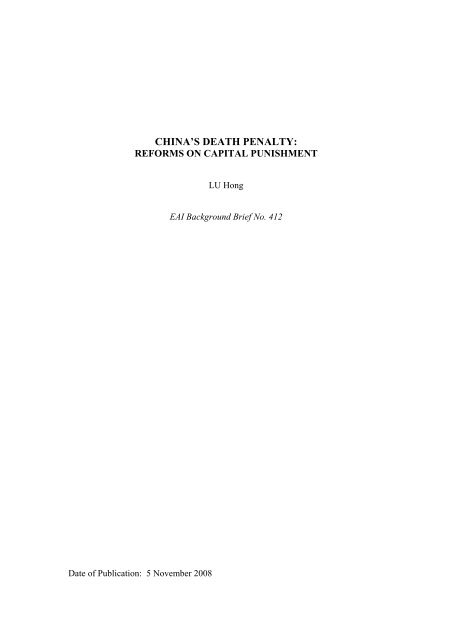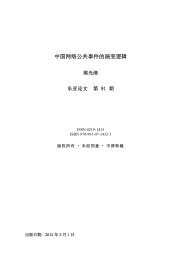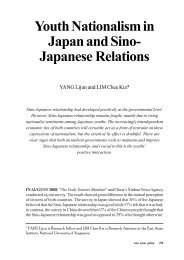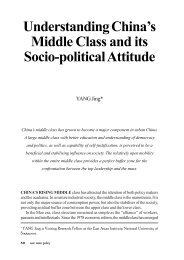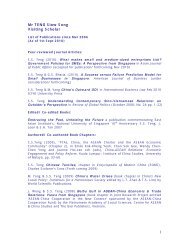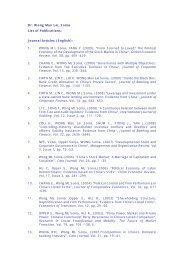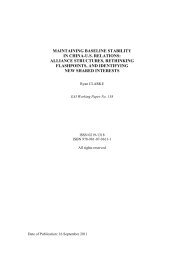CHINA'S DEATH PENALTY: - East Asian Institute
CHINA'S DEATH PENALTY: - East Asian Institute
CHINA'S DEATH PENALTY: - East Asian Institute
Create successful ePaper yourself
Turn your PDF publications into a flip-book with our unique Google optimized e-Paper software.
CHINA’S <strong>DEATH</strong> <strong>PENALTY</strong>:<br />
REFORMS ON CAPITAL PUNISHMENT<br />
LU Hong<br />
EAI Background Brief No. 412<br />
Date of Publication: 5 November 2008
Executive Summary<br />
1. China topped the world in the imposition of the death penalty. According to<br />
Amnesty International, China’s death sentences and executions have<br />
consistently contributed 60-80% to the total death sentences and executions in<br />
the world.<br />
2. This is compounded by the problem of wrongful convictions and erroneous<br />
executions, particularly as a result of coerced confessions and strike-hard<br />
campaigns in recent decades.<br />
3. China’s official policy on the death penalty is to prevent excessive executions<br />
and to execute with caution ( 少 杀 慎 杀 ).<br />
4. The current Criminal Law stipulates 68 criminal offenses eligible for capital<br />
punishment. These offenses include not only violent crimes, but also economic<br />
offenses, offenses concerning public safety, public order, and corruption,<br />
making the scope of capital offenses one of the most expansive in the world.<br />
5. Moreover, some offenses which meet certain aggravating conditions carry a<br />
mandatory death sentence (i.e., drug trafficking).<br />
6. In general, China’s death penalty has several unique characteristics: 1) it<br />
exempts minors (those less than 18 years of age at the time the crime was<br />
committed) and pregnant women (at the time of adjudication) from the death<br />
penalty; 2) it makes legal representation mandatory for all capital cases; and 3)<br />
it has the suspended death sentence, which may be used when an offender<br />
“should be sentenced to death” but “immediate execution is not essential.”<br />
This is in line with China’s policy of “preventing excessive executions and<br />
executing with caution.”<br />
7. Given these developments of the death penalty in China, the current reform<br />
has focused on several areas: 1) setting up long term prison sentences; 2)<br />
i
estricting the scope of capital offenses; 3) curbing police torture and coerced<br />
confession; and 3) making death sentence decisions more uniform and fairer<br />
by going through the central authority for the final review and approval of<br />
capital cases.<br />
8. With all indications, China is unlikely to abolish the death penalty in the near<br />
future. It will eventually abolish the death penalty when social and economic<br />
conditions permit.<br />
ii
CHINA’S <strong>DEATH</strong> <strong>PENALTY</strong>:<br />
REFORMS ON CAPITAL PUNISHMENT<br />
LU Hong ∗<br />
Estimating Death Sentences and Executions<br />
1.1 China does not publish official statistics on the number of death sentences and<br />
executions. It was widely speculated that the actual number of death sentences<br />
and executions might be very high and its release may cause embarrassment<br />
and further international pressure. It is thus believed that once the Supreme<br />
Court is satisfied with its progress of limiting the number and scope of death<br />
sentences and executions, it will release the data.<br />
1.2 The assessment of the prevalence of death sentences and executions in China<br />
came from two sources: 1) Amnesty International annual reports, and 2)<br />
anecdotal reports.<br />
1.3 Data compiled by Amnesty International (AI) are the most cited because every<br />
case reported can be traced to its original source. It also represents the most<br />
conservative estimate of death sentences and executions in China due to the<br />
following accounting rules: 1) when there is doubt of accuracy, figures were<br />
excluded; 2) where two conflicting reports existed, the lower figure was used;<br />
3) when a combined figure of death sentences and prison sentences was given,<br />
only one death sentence was recorded; and 4) when a group was sentenced to<br />
death, only one sentence was entered. 1<br />
∗<br />
Dr Lu Hong is associate professor of Criminal Justice at the University of Nevada, Las Vegas,<br />
USA, and Visiting Senior Research Fellow at EAI. She appreciates Prof John Wong for going through<br />
the drafts of this background brief and his helpful comments.<br />
1<br />
The number of death sentences and executions reported by AI mainly came from publications<br />
and broadcasts from foreign and Chinese state news agencies such as Agence France Presse, the<br />
Associated Press, Agencia EFE, Foreign Broadcast Information Service, People’s Broadcasting Station,<br />
BBC, South China Morning Post, and New China News Agency. See Amnesty International website at<br />
http://web.amnesty.org/library/Index/ENGASA170351997?open&of=ENG-2S2.<br />
1
1.4 Reports containing speculations and estimates from Chinese public officials,<br />
legal practitioners, and scholars also provide an additional source of estimates<br />
of death sentences and executions in China. As an insider and a decision<br />
maker, these officials and practitioners may have inside information about the<br />
death penalty practice in China. However, as these estimates cannot be<br />
documented, the credibility of these estimates is often questioned.<br />
1.5 Figure 1 presents the number of death sentences in China and worldwide. AI’s<br />
estimate of the number of death sentences in China ranged from 1,000 to<br />
6,000 per year. Even though there was no clear increasing or decreasing trend<br />
over a time period (between 1994 and 2008), it is evident that China has<br />
consistently contributed 60-80% to the death sentences worldwide.<br />
8000<br />
7000<br />
6000<br />
5000<br />
4000<br />
3000<br />
2000<br />
1000<br />
FIGURE 1<br />
NUMBER OF <strong>DEATH</strong> SENTENCES IN CHINA<br />
AND WORLDWIDE<br />
0<br />
1994 1995 1996 1997 1998 1999 2000 2001 2003 2004 2005 2006 2007<br />
China<br />
Worldwide<br />
Source: Amnesty International<br />
1.6 Figure 2 shows that the annual number of executions fluctuated over the years<br />
both for China and the world. While the lowest recorded number of executions<br />
in China was 470 in 2008, the highest was 3,400 in 2004. The number of<br />
executions in China consistently accounted for a large proportion of that in the<br />
world. In addition, these estimates from AI were far less compared to<br />
2
estimates from Chinese public officials, practitioners and scholars. It was<br />
reported that China executed between 6,000 and 10,000 people each year.<br />
4000<br />
3500<br />
3000<br />
2500<br />
2000<br />
1500<br />
1000<br />
500<br />
FIGURE 2<br />
NUMBER OF EXECUTIONS IN CHINA<br />
AND WORLDWIDE<br />
0<br />
1994 1995 1997 1998 1999 2000 2001 2002 2003 2004 2005 2006 2007<br />
China<br />
Worldwide<br />
Source: Amnesty International<br />
1.7 China has 68 types of criminal offense that are eligible for capital punishment.<br />
These capital offenses encompass a wide variety of offense types including<br />
drug trafficking, terrorism, producing or distributing poisonous, harmful or<br />
shoddy goods or medicines, forcing others into prostitution, and financial<br />
instrument and/or credit card frauds. These new capital offenses indicate a<br />
shift in the Chinese government’s concerns from political interests in the past<br />
to economic and social issues in the present. Table 1 presents capital offenses<br />
stipulated in the 1997 Criminal Law.<br />
3
TABLE 1<br />
OFFENSES LIABLE FOR CAPITAL PUNISHMENT AS<br />
STIPULATED IN THE 1997 CRIMINAL LAW<br />
Crimes Endangering National Security (7 capital offenses)<br />
• Plotting to jeopardize the sovereignty, territorial integrity and security of the country<br />
• Instigating to split the country<br />
• Organizing, plotting, or carrying out armed rebellions, or armed riots<br />
• Organizing, plotting or acting to subvert the political power of the state<br />
• Espionage<br />
• Stealing, secretly gathering, purchasing by bribery or illegally providing national secrets or<br />
intelligence to foreign institutions<br />
• Providing the enemy with armed equipment or military materials<br />
Crimes Endangering Public Security (14 capital offenses)<br />
• Arson<br />
• Breaching dikes<br />
• Causing explosions<br />
• Poisoning<br />
• Threatening public security with dangerous methods<br />
• Sabotaging transportation instruments<br />
• Sabotaging transportation infrastructures<br />
• Sabotaging electric power<br />
• Sabotaging inflammable or explosive facilities<br />
• Hijacking an aircraft<br />
• Illegally manufacturing, trading, transporting, and mailing guns, ammunition or explosives<br />
• Illegally trading or transporting nuclear materials<br />
• Stealing guns, ammunition or explosive materials<br />
• Forcibly seizing guns, ammunition or explosive materials<br />
Crimes Undermining the Socialist Market Economic Order (15 capital offenses)<br />
• Producing or distributing bogus medicines<br />
• Producing or distributing poisonous or harmful foods<br />
• Smuggling weapons and ammunitions<br />
• Smuggling nuclear materials<br />
• Smuggling counterfeit currencies<br />
• Smuggling cultural relics<br />
• Smuggling precious metals<br />
• Smuggling rare plants and their products<br />
• Counterfeiting currency<br />
• Fund-raising frauds<br />
• Financial instrument frauds<br />
• Letter of credit frauds<br />
• Credit-card frauds<br />
• Illegally issuing value-added tax invoices<br />
• Counterfeiting or selling counterfeit value-added tax invoices<br />
Crimes Infringing upon the Rights of the Person and his Democratic Rights (5 capital offenses)<br />
• Murder<br />
• Rape<br />
• Statutory rape<br />
• Kidnapping<br />
• Abducting women and children<br />
Crimes Encroaching on Property (2 capital offenses)<br />
• Robbery<br />
• Theft<br />
4
Crimes Disrupting the Order of Social Administration (8 capital offenses)<br />
• Imparting criminal methods<br />
• Organizing a jail break<br />
• Prison riots using weapons<br />
• Illegally digging and robbing ancient remains or tombs<br />
• Illegally digging or robbing fossils of ancient human beings or fossils of ancient vertebrate<br />
animals<br />
• Smuggling, trafficking, transporting or manufacturing narcotics<br />
• Organizing another person to engage in prostitution<br />
• Forcing another person into prostitution<br />
Crimes Endangering the National Defense Interest (2 capital offenses)<br />
• Sabotaging military weapons, military installations or military communications<br />
• Knowingly providing unqualified weapons or military installations to the armed forces<br />
Crimes of Graft and Bribery (2 capital offenses)<br />
• Graft<br />
• Bribe-taking<br />
Crimes of Violating Duties of Military Servicemen (13 capital offenses)<br />
• Refusing to carry out an order in wartime<br />
• Deliberately concealing military intelligence, furnishing falsified intelligence<br />
• Refusing to disseminate military orders, or falsely disseminating military orders<br />
• Surrendering to the enemy<br />
• Deserting on the eve of a battle<br />
• Obstructing commanding officers or on-duty servicemen from carrying out their duties<br />
• Defecting to a foreign country<br />
• Illegally obtaining military secrets<br />
• Illegally providing military secrets to foreign organs<br />
• Fabricating rumors to mislead people during wartime<br />
• Stealing or robbing weapons or military materials<br />
• Unlawfully selling or transferring military weaponry<br />
• Injuring or killing innocent residents or looting property from innocent residents during<br />
wartime<br />
Source: Luo, Wei. The 1997 Criminal Code of the People’s Republic of China (Buffalo, NY: William<br />
S. Hein & Co., Inc., 1998).<br />
1.8 The average age of capital offenders who received a death sentence was 32<br />
years (ranging from 17-67 years of age). The majority of these offenders were<br />
male (93%), 2 with a low occupational status (67%) and a migrant status (42%).<br />
A substantial number of capital offenders had a criminal record (14%), which<br />
was two times more than non-capital offenders (7%). In addition, only 15% of<br />
2<br />
7% of capital offenders were female in China compared to only 0.6% in the U.S. If restricting<br />
the type of offenses to violent crimes, there were even more female offenders receiving a death<br />
sentence in China than those in the U.S (see Lu and Miethe, 2007, pp.78-79; Streib, Victor, Death<br />
Penalty for Female Offenders: January 1, 1973 through June 30, 2007, 2007, available at<br />
http://www.deathpenaltyinfo.org/FemDeathJune2007.pdf).<br />
5
capital offenders confessed to the crime, which was significantly lower than<br />
non-capital offenders who confessed to their crimes (40%). 3<br />
1.9 The severity of capital offenses has also been assessed. For example, an<br />
overwhelming majority of violent offenses receiving a death sentence had<br />
resulted in at least one death (81%). For corruption cases, offenses that<br />
received the death sentence involved much more money on average than those<br />
of a non-death sentence. 4<br />
1.10 The length it took to process capital cases was also assessed using the same<br />
dataset. The result indicates that the average days for capital cases to conclude<br />
without the final review by the Supreme Court was 273 days (ranging from 7<br />
to 1,960 days), and with the final review and approval by the Supreme Court<br />
was 449 days (ranging from 62 to 1,965 days). 5<br />
1.11 The time spent on the death row was relatively short. According to China’s<br />
Criminal Procedure Law (1996), “after receiving an order to execute the death<br />
sentence from the Supreme People’s Court, the people’s court at lower levels<br />
shall, within seven days, deliver the criminal for execution of the sentence.”<br />
1.12 There are two execution methods in China: execution by shooting or by lethal<br />
injection. Lethal injection was introduced in 1997 and in remote western<br />
regions first, and then gradually implemented in other jurisdictions.<br />
3<br />
The “non-death sentence” here refers to one of these sentences: a suspended death sentence,<br />
life imprisonment, or a fixed prison sentence of more than 10 years (See Lu and Miethe, 2007, pp.77-<br />
84).<br />
4<br />
For example, the mean value involved in corruption cases was 10 million yuan for those with<br />
a death sentence; 400,000 yuan for those with a suspended death sentence or life imprisonment, and 4<br />
million yuan for those with a prison sentence longer than 10 years (See Lu and Miethe, 2007, pp.84-87).<br />
5<br />
Lu and Miethe, 2007, pp.104-112.<br />
6
The Policy of Preventing Excessive Execution and Executing with Caution<br />
( 少 杀 慎 杀 )<br />
2.1 China has had a long history of the death penalty with the earliest available<br />
record dating back to the Shang Dynasty (1700-1027 BC). 6 It is a long<br />
historical tradition throughout the dynastic rules, the Republic era, and the<br />
PRC era that justifies capital punishment on the grounds of retribution,<br />
deterrence, and incapacitation. Chinese traditional sayings like “a life for a<br />
life,” “killing one to warn a hundred,” “killing a chicken to warn a monkey”<br />
are embodiments of these retributive and deterrent beliefs.<br />
2.2 Throughout the PRC history, the death penalty has been used as a tool to<br />
suppress crime and maintain social order. It was heavily relied upon during the<br />
early 1950s to suppress counterrevolutionary activities and corruption. It was<br />
again utilized during the strike-hard campaigns (from the 1980s to the present)<br />
to swiftly and severely ( 从 快 从 重 ) punish offenders. 7<br />
2.3 Nevertheless, a more consistent official policy on the death penalty has been<br />
“to prevent excessive execution and execute with caution” ( 少 杀 , 慎 杀 ). For<br />
example, in the 1950s, Mao stated that offenders who did not have “blood<br />
6<br />
Five Punishments ( 五 刑 ) were codified as the major forms of punishment including<br />
permanent branding on the offender’s face ( 墨 ), amputation of the offender’s nose ( 劓 ), feet ( 剕 ),<br />
male’s reproductive organ or locking a woman up for life ( 宫 ), and the death penalty ( 大 辟 ). Liu,<br />
Yongping, Origins of Chinese Law – Penal and Administrative Law in its Early Development (New<br />
York: Oxford University Press, 1998).<br />
7<br />
For example, during the 1950s, Mao stressed the need to “strike surely, accurately and<br />
relentlessly” to suppress counterrevolutionaries and corruption. The number of executed<br />
counterrevolutionaries was quite “substantial” in today’s standards. Liu, Renwen, 死 刑 政 策 : 全 球 视<br />
野 及 中 国 视 角 (Death Penalty Policies: The World View and China’s Perspectives), 2003. Posted on<br />
the website of the University Services Centre of the Chinese University of Hong Kong at<br />
http://www.usc.cuhk.edu.hk/wk_wzdetails.asp?id=2623. Accessed on July 31, 2008.<br />
Strike-hard campaigns from 1983 also resulted in an estimated tens of thousands of executions,<br />
particularly those involving violent crimes and crimes endangering public security (see Palmer,<br />
Michael. “The People’s Republic of China.” In Capital Punishment Global Issues and Prospects, eds.<br />
Peter Hodgkinson and Andrew Rutherford. UK: Waterside Press, 1996. Trevaskes, Susan. “Courts on<br />
the Campaign Path in China: Criminal court Work in the “Yanda 2001” Anti-Crime Campaign.” <strong>Asian</strong><br />
Survey 2002 42(5): 673-693. See also various Amnesty International Reports.<br />
7
debt”<br />
“ 血 债 ” and those offenses that did not cause grand public indignation,<br />
should be given the suspended death sentence ( 死 缓 ). 8<br />
2.4 Post-Mao leaders also voiced their views on the death penalty. Deng, who<br />
initiated the strike-hard campaigns in light of the rampant crimes, commented<br />
that the authorities could not be soft on crime, and the death sentence was “a<br />
necessary educative tool” in dealing with a few most serious offenses. 9<br />
Current leaders, such as President of the PRC Hu Jintao, Premier Wen Jiabao<br />
and President of the Supreme Court Xiao Yang, have stated that China cannot<br />
abolish the death penalty under the current social conditions, but it will make<br />
sure that the death sentence is meted out fairly and cautiously.<br />
2.5 The current policy on the death penalty can be summarized as follows: 1) the<br />
death penalty cannot be abolished ( 不 可 不 杀 ); 2) the death penalty cannot be<br />
used excessively ( 不 可 滥 杀 ); and 3) erroneous executions should be avoided<br />
( 不 可 误 杀 ). 10 The Supreme Court, which has been entrusted with reviewing<br />
cases given a death sentence in 2007, signaled the reaffirmation of this policy<br />
of preventing excessive executions and execution with caution.<br />
Unique Characteristics of China’s Death Penalty<br />
3.1 China’s death penalty has several unique characteristics. First, minors are<br />
exempted from the death penalty because of their intellectual, mental and<br />
psychological development. The current criminal law stipulated that only<br />
offenders of eighteen years or older could be sentenced with the death penalty.<br />
In addition, women who are pregnant at the time of adjudication are exempted<br />
from the death penalty.<br />
8<br />
Zhang, Zhengxin, Theory and Practice of the Suspended Death Penalty System in China<br />
(Wuhan, China: Wuhan University press, 2004), p.13.<br />
9<br />
Deng, Xiaoping, Selected Works of Deng Xiaoping, Third edition (Beijing: People’s<br />
Publishing House, 1983), p. 90 & p.173.<br />
10<br />
Chen, Xingliang, The New Horizon of Contemporary Criminal Law in China (Beijing, China;<br />
The Chinese University of Politics and Law Press, 2002), P.544.<br />
8
3.2 Second, legal representation is mandatory for all capital cases. In cases where<br />
defendants charged with the death sentence did not wish to hire a private<br />
attorney or did not have the financial resources to do so, the court must<br />
appoint a defense attorney, unless the defendant declined legal representation.<br />
3.3 Third, suspended death sentence is a hallmark of China’s death penalty.<br />
China’s law required that the suspended death sentence may be applied when<br />
an offender “should be sentenced to death,” but “the immediate execution is<br />
not essential.” This practice is consistent with China’s punishment philosophy<br />
of education and deterrence.<br />
Ongoing Reforms and Future Prospects<br />
Setting up long term prison sentences<br />
4.1 It was argued that the reason why death penalty was used frequently in China<br />
was because there were no other comparable alternatives. Currently by law,<br />
the longest prison sentence is 15 years. Even though life imprisonment is<br />
available, the average time an offender served behind bars with a life<br />
imprisonment sentence is 15 years. Thus it is important to set up longer prison<br />
terms (i.e., 20-30 years), or to make life imprisonment without the possibility<br />
of parole an option, so as to reduce the need for the death penalty.<br />
Restricting the scope of capital offenses<br />
4.2 The current Criminal Law specified 68 criminal offenses punishable by death.<br />
Among them, about one third of the capital offenses have rarely been used in<br />
practice; another one third consisted of nonviolent, non-lethal offenses (i.e.,<br />
corruption, economic offenses, and public order offenses). It was proposed to<br />
gradually narrow the scope of capital offenses by eliminating the offenses<br />
rarely used first, and then the nonviolent and non-lethal offenses. The final<br />
step would be the complete abolition of the death penalty.<br />
9
Curbing police torture and coerced confession<br />
4.3 Coerced confessions have been found to be linked to almost all erroneous<br />
executions publicized in recent years. The combination of an overemphasis on<br />
confession evidence, lack of exclusionary rules, and a rare and lenient<br />
disposition on violators of illegal torture, have all contributed to the<br />
prevalence of torture and coerced confessions. Several proposals have been<br />
made to curtail this problem, including allowing the presence of lawyers,<br />
and/or recording or videotaping of the entire process of police interrogation,<br />
judiciary oversight of police misconduct, a stricter criminal/administrative<br />
penalty for abusing police power, and a more effective implementation of<br />
current laws regarding criminal punishment for judiciary misconduct, and the<br />
State Compensation Law. It was also proposed that suspects/defendants<br />
should enjoy the right not to self-incriminate to serve as an additional<br />
safeguard for coerced confession.<br />
Centralizing the authority for final review and approval of the death sentence<br />
4.4 The Supreme Court had been reassigned the task of making a final review and<br />
approving all death sentences in 2007, and is recruiting and training a large<br />
number of judiciary officers for its expanded criminal division. This has been<br />
widely viewed as an effort to implement the death penalty with uniformity,<br />
fairness, and caution.<br />
4.5 A more drastic measure involved a call for the complete abolition of the death<br />
penalty in China. It was reasoned that China’s death penalty is justified based<br />
on two premises: 1) retribution (primarily based on the public’s indignation<br />
[ 民 愤 ]); and 2) deterrence ( 威 慑 力 ). However, historical and cross-national<br />
research suggests that public opinion on the death penalty has no correlation<br />
with the death penalty status of a nation. Moreover, empirical research found<br />
mixed results about the deterrent effects of the death penalty. It was suggested<br />
that if life imprisonment without the possibility of parole is made available,<br />
and prison sentence is lengthened (currently it is 15 years), abolishing the<br />
10
death penalty could be realized without compromising public safety and public<br />
morale.<br />
4.6 In sum, the progressive view on the death penalty seems to dominate the<br />
current policy. The reforms on the death penalty also appear to work toward<br />
realizing the policy of “preventing excessive executions and executing with<br />
caution”. The complete abolition of the death penalty remains only a longterm<br />
goal in China.<br />
11
APPENDIX 1 NUMBER OF COUNTRIES THAT HAVE ABOLISHED<br />
THE <strong>DEATH</strong> <strong>PENALTY</strong> IN LAW OR IN PRACTICE BY YEAR<br />
140<br />
120<br />
100<br />
80<br />
60<br />
40<br />
20<br />
0<br />
1981 1983 85 87 89 91 93 95 97 99 2001 2003 2005 2007<br />
Year<br />
Source: Amnesty International<br />
APPENDIX 2 COUNTRIES WITH HIGHEST NUMBER OF EXECUTIONS - 1996-<br />
2000 (ANNUAL RATE PER MILLION)<br />
* Singapore - 6.40 (112 persons)<br />
* Saudi Arabia - 4.46 (446 persons)<br />
* Belarus - 2.48 (130 persons)<br />
* Iran - 1.76 (559 persons)<br />
* China - 1.65 (10,275 persons)<br />
* United States - 0.027 (370 persons)<br />
APPENDIX 3<br />
EXECUTION METHODS IN CHINA<br />
* Execution by Shooting (From 1949 to current)<br />
* Execution by lethal injection<br />
- Inaugural use in 1997 by Kunming Intermediate Court, Yunnan province<br />
- 2002, the Supreme Court issued the Notice on Using Lethal Injection in<br />
Executions to ensure standardization<br />
12


